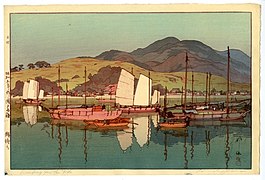Yoshida Hiroshi

Yoshida Hiroshi ( Japanese 吉田 博 ; born September 19, 1876 in Kurume ; died April 5, 1950 ) was a Japanese painter and woodblock artist.
Career
Yoshida was born the son of the samurai Ueda Tsukane ( 上 田 束 秀 之 ) in Kurume (Kyūshū). His family moved frequently, which made travel, as he later said, second nature to him. One of his teachers, Yoshida Kasaburō ( 吉田 嘉三郎 ), recognized his talent and adopted him. In 1893 Yoshida studied painting in the western style with Tamura Sōryū in Kyōto. In 1894 he went to Tōkyō and continued his education at the private Fudosha school.
In 1899 he traveled to the USA and had an exhibition in Boston with his watercolors, which were well received. He now had enough money to travel to Europe and visit France, Switzerland, Italy and Germany. He first traveled back to the USA before returning to Japan. 1903-06 he traveled again in the USA and Europe.
In 1910 he was elected to the jury of the colorful exhibition for the first time (it was the fourth). In 1920 he got to know Watanabe Shōzaburō and produced the first template for a woodcut for him. When Watanabe's printing blocks were lost in the Great Kanto earthquake in 1923 , he fled to a certain extent with his wife to the United States and traveled on to Europe until he returned to Japan in August 1925.
In 1929 he traveled to India and Southeast Asia. He continued his successful exhibition activity and continued to serve on the jury of the annual state exhibition, which was renamed Teiten. During the war, the government sent him to China as one of the painters and brought back drawings for woodcuts from there.
In 1946 his last woodcut was published, “A Farmhouse”. In 1947 he became president of the Taiheiyō gakai artists' association . He fell ill in October 1949 and died in April of the next year.
Act
Yoshida began his career with watercolors. When he switched to woodcuts from 1920 onwards, he tried to transfer the fine color gradations of the watercolor to the woodcut. After initially creating templates for Watanabe, he founded his own printing company around 1925. He then signed his sheets with "self-peeled" (自 刷 り, jizuri), strictly speaking he only carefully monitored the printing. Up to 60 printing processes are said to have been carried out (several times with each plate) for one sheet in order to realize the fine shading.
Yoshida dealt almost exclusively with the reproduction of landscapes and places, capturing his motifs worldwide.
Mostly Yoshida is assigned to the Shin-hanga movement, but his western style and the execution of his prints make him a special case.
photos
Remarks
- ↑ Bunten is the abbreviation for the annual exhibition Mombushō tenrankai organized by the Japanese Ministry of Culture ( Mombu-shō )
literature
- Riccar Art Museum: Collection of the Wood-block Prints by Hiroshi Yoshida. 1976.
Web links
| personal data | |
|---|---|
| SURNAME | Yoshida, Hiroshi |
| ALTERNATIVE NAMES | 吉田 博 (Japanese); 上 田 博 (maiden name, Japanese); Ueda Hiroshi (maiden name) |
| BRIEF DESCRIPTION | Japanese painter |
| DATE OF BIRTH | September 19, 1876 |
| PLACE OF BIRTH | Kurume |
| DATE OF DEATH | April 5, 1950 |






